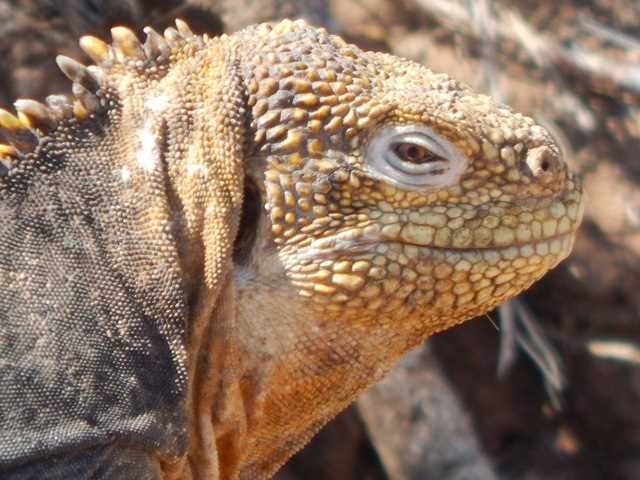Traveling via Zodiac to Cerro Dragon, an arid region on the leeward side of Santa Cruz Island, we hoped to be greeted by the yellow land iguanas. Walking across lava rocks and through a white sand beach with plentiful Sally Lightfoot crabs and basking marine iguanas greeting us at disembarkation, we followed a trail through a giant prickly pear cacti forest. Opening up to a lagoon, the contrast of the blue waters, red soil, green prickly pear, and yellow succulents with black-necked stilts wading the waters created a picturesque landscape. However, we still had not yet found our endemic Galapagos land iguanas.
Due to the introduction of donkeys, goats, and feral cats, the yellow land iguanas fight to maintain their population. Our naturalist pointed out barren trunks of the cacti and commented on the shrinking numbers of land iguanas. After finding several burrows, we finally found our first yellow land iguana, with a striking crest that would impress the females. Hiking along the trail, we discovered about ten land iguanas, a decrease from the twenty or so observed by naturalists on previous visits. The impact of introducing non-native species to this area was apparent, but we can impart this knowledge to others to do our part in re-establishing this magnificent species.
The marine iguanas have not been impacted as hard on this island, and they really put on a show for us, showing us their Godzilla-like qualities—one even glided into the water and swam toward our zodiac!
We returned back to the ship around 10:00 and quickly changed into our snorkel gear. The more adventurous of us went to an area called Guy Fawkes Islets, where we had the opportunity to observe many varieties of fish, various invertebrates, and a sea lion! The water was much more pleasant than in previous days, though in some areas the water was quite choppy. Instead of going deep water snorkeling, a second option was to go to a white sand beach to swim and snorkel. It was a gorgeous day for both options, so all returned satisfied.
For lunch today we ate typical Ecuadorian fare for lunch. It was delicious! The afternoon was much more relaxed than usual and included some down time. Socrates, one of the naturalists, gave a presentation on Darwin in the lounge followed by the documentary “What Darwin Never Saw.” In the evening, we circumnavigated Daphne Major Islet. This was perfect timing—today’s documentary discussed Peter and Rosemary Grant, who made this islet famous for tagging all of its finches over a 20-year period.
As the sun set, we gathered on the foredeck to observe Daphne Major. Wine tasting and good conversation were perfect additions to the evening. Afterwards, naturalists Aura and Gaby gave presentations about the island followed by dinner. Tomorrow we explore Bartolomé and Sombrero Chino—it should be another exciting day in the Galapagos!







